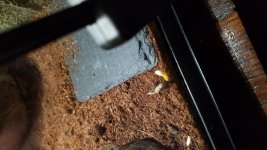I've had her for about 6 months now, she was gifted to me by my professor so I'm not sure how old she is but only know that shes an adult female. I currently feed her large crickets and dust them with calcium (zoo med calcium w/o D3) 3 feeds and 1 feed vitamins (rep-cal srp00300 herptivite multivitamin and mineral powder. I feed her every 2-3 days about 10 crickets depending on how many she will take from me. I feed the crickets the fluckers orange complete diet cubes and the fluckers cricket quencher. I used to give her meal worms but noticed that it was harder for her to digest them because of their hard exoskeleton in comparison to the crickets.
My warm ground temp is btwn 86-90 F. Her moist hide im not sure what temp it is. I simply have a coconut filled with moss that i spritz water with. She usually goes in there when shes about to shed and when shes done shedding she will spend the day there.
cool end hide temp is a little higher than 75. It could be higher due to us amping up the heater in our house. I tend to turn off the heating mat at night just to imitate outside temperatures, it will usually drop the lowest to 68 F. I have a digital thermostat controller measuring the temps of the tank.
Please share a photo and her total length. If you have a weight, please share that too.
I highly recommend raising the warm end temp to 88-92*F during the day. Keeping her warm moist hide on the warm end helps too.
Is your "digital thermostat controller" actually a thermostat or a rheostat? Does it shut off the heat mat when temps exceed a certain pre-set temp? If so, it can automatically be timed to turn off at night. An inexpensive analog timer will do the trick.
You mention Zoo Med's Repti Calcium (plain - no D3) and Rep-Cal's Herptivite. Are you dusting with any vitamin D3 source?
Fluker's Orange Cubes contain very little protein,
et cetera. Crickets need some dry diet with a better mix of ingredients. Geckos, too, are what they eat. I use finely ground Zoo Med's Natural ADULT Bearded Dragon Food for my crickets. The crickets just about lick their plates. Professional Reptiles' Pro Gutload mix is good and inexpensivel
Adult leos can easily be kept healthy on 2 feedings per week. Schedule 126 is a good one to follow.
Weekly Schedule 126 for Leopard Geckos 18 months old +
(withOUT UVB)
Early stage metabolic bone disease (MBD) problems include uneven (lopsided) gait, bowed limbs, belly dragging, and an underbite.
- Crickets or dubia >> Monday - lightly dusted with Zoo Med's Repti Calcium with D3
- Crickets or dubia >> Thursday - lightly dusted with Zoo Med's ReptiVite multivitamins withOUT D3
- Optional: Mealworms or Black Soldier Fly Larvae (Phoenix worms) >> Saturday - no dusting







